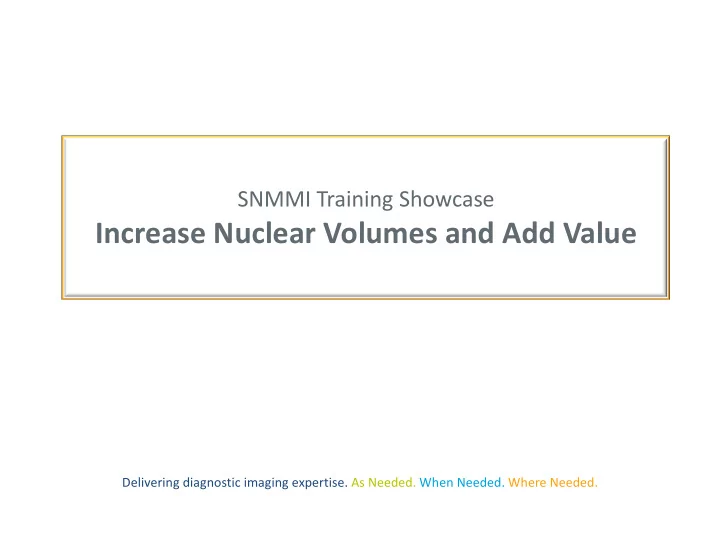

SNMMI Training Showcase Increase Nuclear Volumes and Add Value Delivering diagnostic imaging expertise. As Needed. When Needed. Where Needed.
Challenges we face in Healthcare today: • Nuclear medicine volumes are down • Value-Based care is upon us • Patient Satisfaction is key • Risk Management is more important than ever How are you keeping your department relevant in today’s environment?
Dealing with lower volumes? The nuclear medicine departments that are seeing an increase in volumes are the ones expanding their services and improving patient care…
Are you running a Full-Service Department? Or Are you only performing Nuclear Medicine…in Nuclear Medicine? Expand your services… Emergency Department (ER) Critical Care (ICU) Surgery (OR) Pediatrics Women’s health
How?
Point-of-Care Imaging
Multiple Nuclear Medicine departments have reported an increase in studies using Point-of-Care Imaging: Brain Viability § Intraoperative Imaging § Lymphoscintigraphy § GI Bleed § Lung Perfusion § HIDA § MUGA § Bone Flow/Blood Pool §
Clinical Study: Imaging in the OR Intraoperative Scintigraphy Using a Large Field-of- View Portable Gamma Camera for Primary Hyperparathyroidism: Initial Experience Conclusion: Real time intraoperative imaging has the ability to… • Accurately identify MIBI-avid parathyroid adenomas • Ability to confirm complete resection of MIBI-avid parathyroid adenomas • Accurately predict the end of the operation an average of 25 to 30 minutes faster. Source: Article published by Nathan C. Hall et al. in BioMed Research International Volume 2015, Article ID 930575, http://dx.doi.org/10.1155/2015/930575
Intraoperative Scintigraphy using Pre Surgery Image LFOV Gamma Camera Pre Surgery PTH: 118.2 pg/ml Post Surgery Image Post Excision PTH: 52 pg/ml
Clinical Study: Imaging in Pediatric Surgery Abstract - Use of intraoperative nuclear imaging leads to decreased anesthesia time and real-time confirmation of lesion removal Background Lymphatic mapping to guide sentinel lymph node biopsy (SLNB) typically requires lymphoscintigraphy prior to surgery. In young pediatric patients, this process often requires intubation in the nuclear medicine suite followed by transport to the operating room (OR). Methods We reviewed 14 pediatric cases in which a portable nuclear imaging camera was utilized to perform the entirety of the SLNB in the OR. Results and Conclusion This method, utilizing intraoperative nuclear imaging, helped to confirm removal of the sentinel lymph node in real time, decreased anesthesia time, and avoided transport of a sedated or intubated child. Source: Article published in Journal of Pediatric Surgery January 2018 Volume 53, Issue 1 https://www.jpedsurg.org/article/S0022-3468(17)30641-3/fulltext
Thyroid Cancer Case • 3.9 mCi I 123 po dose. • Shows significant residual thyroid tissue after a TOTAL thyroidectomy. Scan done a few months • before the actual surgery to remove nodes.
Thyroid Cancer Case • Illustrates successful node removal after a 2 nd attempt. • Without intra-op L/S imaging, surgeon would not have known he/she did not successfully remove the targeted node on the 1 st attempt. • Completion film indicating removal of LN
Melanoma – Nevus case • Pre-op L/S indicates 2 ROI/nodes • After attempt 1, residual node #1 identified. • After attempt #2, node #1 still present. • After attempt #3, only injection site identified.
Value = (Quality + Outcomes) Cost
Risk Factor: Patient Transport Abstract – Intra-hospital transportation of critically ill patients is associated with significant complications: Source: Abstract by Patrick H Knight et al, in Int J Crit Illn Inj Sci. 2015 Oct-Dec; 5(4): 256–264. https://www.ncbi.nlm.nih.gov/pmc/articles/PMC4705572/
Risk Factor: Patient Transport Factors contributing to complications during intra-hospital transports. Care delivered during transport and at the site of diagnostic testing or procedure should be equivalent to the level of care provided in the originating environment. Source: Abstract by Patrick H Knight et al, in Int J Crit Illn Inj Sci. 2015 Oct-Dec; 5(4): 256–264. https://www.ncbi.nlm.nih.gov/pmc/articles/PMC4705572/
Patient Transport
Costs of Patient Transport Registered Respiratory Nurse Therapist $33 / hour $31 / hour Patient Transporter Critical Care $13 / hour Nurse $33+ / hour
Costs of Equipment Transport NMT $37 per hour
Abstract: Point-of-Care Nuclear Imaging Objective: Provide bed-side imaging services to our most critically ill patients unable to be transported to the imaging suite due to their unstable condition. Benefits of Point of Care Imaging: Multiple and diverse clinical applications • Increased clinical utility • Increased patient safety and satisfaction • Elimination of the need to transport critically ill patients • Improved clinical outcomes • Increased medical staff efficiency and productivity • Reduced examination time, thus more cost-effective • Source: Abstract presented at SNMMI 2014 and published by Children’s Hospital of Pittsburgh of UPMC in Journal Of Nuclear Medicine May 2014, vol 55
Journal of Emergencies, Trauma, and Shock Article - Brain death: Diagnostic clues on imaging Conclusion: The early recognition of brain death facilitates organ harvesting and termination of unnecessary treatment and life support. Source: Abstract by Aruna R. Patil, et. Al. in J Emerg Trauma Shock. 2012 Oct-Dec; 5(4): 372–373. https://www.ncbi.nlm.nih.gov/pmc/articles/PMC3519061/
It’s not portable imaging, it’s “ Point-of-Care ” imaging
It is NOT your father’s single head/portable camera!!
It’s….Ergo™ ● Smaller ● Lighter ● No motor required ● Easy to move and maneuver ● Narrow 29” width
It’s the ONLY Solid-state, LFOV nuclear camera for Point-of-Care 12.25” LFOV 15.5” 4 th Generation Solid State Detector • • Patented Csl/Photodiode Technology • Large Field of View • 3.25 mm intrinsic resolution • 7.9% energy resolution
Additional Benefits of Ergo • Can be used in Nuclear Medicine • Improve camera optimization/utilization • Flexibility provides more options for image positioning • Comfortable patient experience
Expand with Versatility • Bone scans • Lung perfusion • Liver study • HIDA gallbladder • Gastric Emptying • GI Bleed • Renal • Thyroid • Parathyroid • Brain Flow • MUGA • MBI • Gallium • Indium • 3 Phase Bone • Sentinel Node • Lymphoscintigraphy
Address today’s issues with Point-of-Care Imaging: ü Increase Nuclear Volumes ü Provide Value-Based Care ü Improve Patient Satisfaction ü Reduce Risk to Patients
Recommend
More recommend